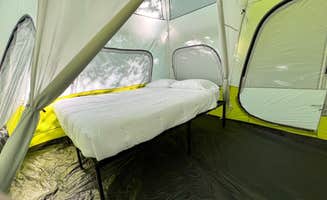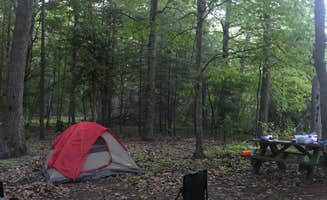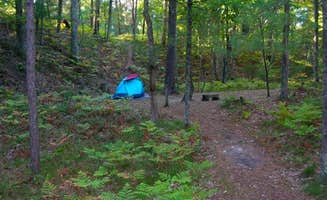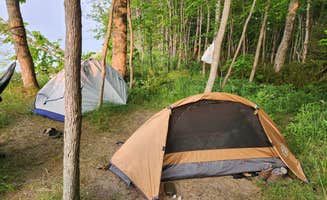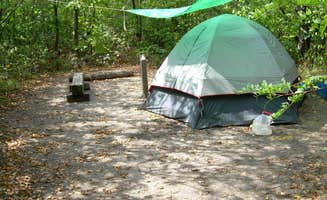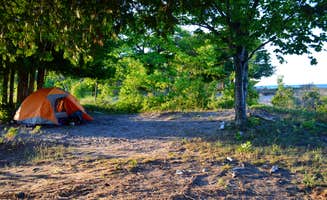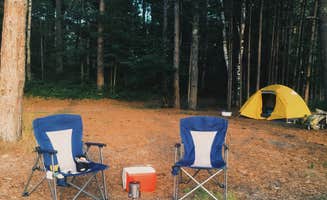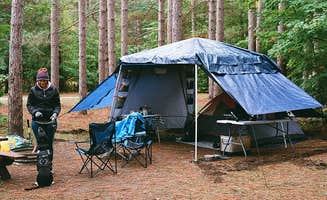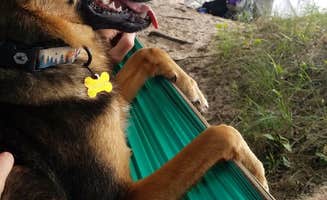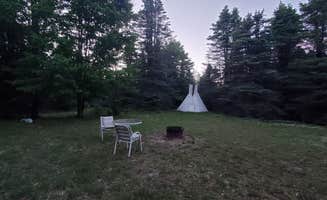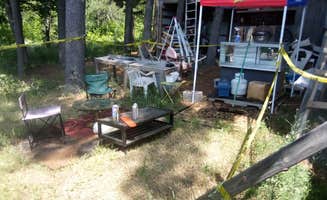Tent camping near Cedar, Michigan provides access to multiple islands and secluded forest areas around Grand Traverse Bay. The region sits at approximately 800 feet above sea level with summer temperatures averaging 75-80°F during daytime and 55-60°F at night. Camping permits for Sleeping Bear Dunes National Lakeshore locations must be obtained in advance and cost $10 per night per site.
What to do
Hike inland trails: Sand Lakes Quiet Area features multiple hiking paths around several lakes with abundant fishing opportunities. "We struggled to find this place and knew with the reviews it was possible. We ended up googling it on Google maps because the location on here was off and that got us closer," reports Rachael T., who recommends following the smaller trail to the left after walking down the main path for about 10 minutes to locate campsites.
Fish in clear waters: Sand Lakes Quiet Area Backcountry Campsites offers exceptional fishing in crystal-clear lakes. "Literally, some of the best fishing I have ever done. We caught so many bass we lost count. Well gave up counting. Like every other cast," shares Dan K., who enjoyed the multiple lakes and ample hiking options.
Visit historical sites: North Manitou Island contains abandoned buildings, ruins, and century-old orchards to explore. "Once on the Island it's up to you. Choose one of many trails to explore and distance is your choice to one of the many outback camps," writes Michelle S., who hiked the island with her 7-year-old son. She notes you might "catch sight of one of the many freighter ships passing by in the shipping lanes past the island."
What campers like
Morning solitude: Campers appreciate the quieter early hours at Power Island County Park Primitive Campsites, accessible only by boat from Bower's Harbor marina. "We kayaked with all our gear!! If you do this, Early morning! Past 2pm forget about it," advises Erin O., who notes the Caribbean-blue waters are visible to depths of 10 feet or more.
Site privacy: Popple Campground on South Manitou Island offers well-separated campsites despite its small size. "The nice thing about a smaller campground and less sites is that they were separated really well. There was quite a bit of space between the sites, so it didn't feel like you were right on top of each other," explains Ashley W., who found only about 5 other families during a mid-July visit.
Accessible wildlife viewing: Campers frequently spot deer, chipmunks, and sometimes hear coyotes on North Manitou Island. "By day you can see animals ranging from chipmunks to one of the many whitetail deer that roam the island," reports Michelle S., adding that the absence of motor vehicles creates "a secluded escape into the northern Michigan nighttime sky's."
What you should know
Water supply planning: Most island campsites require water filtration or carrying supplies. "The solar driven well is no longer operating so grab your water from Lake Michigan and treat it accordingly," advises Daniel S. about Weather Station Campground, which offers back country camping with minimal amenities.
Weather preparations: Pack extra food and appropriate gear for changing conditions. "Bring plenty of food and weather gear as you never know what Northern Michigan can bring as far as storms. The ferry doesn't run if the weather is to grieve for safety so you never know if you could be on the island for a few days," cautions Michelle S. about Village Campground — Sleeping Bear Dunes National Lakeshore.
Wildlife precautions: Protect food from small animals at island campsites. "We hung our food to keep the chipmunks out of it- they did chew on my sunglasses case that I left out!" reports Amy S. about South Manitou Island Group camping, where she stayed at a site near the ferry drop-off with a small trail to Lake Michigan.
Tips for camping with families
Choose accessible sites: Bay Campground — Sleeping Bear Dunes National Lakeshore provides easier access for families with children. "This campground is near the lake and about a mile from the ranger station. Less traveled place and so much to explore. BEAUTIFUL hiking!" notes camper GoWhereYouAreDraw N., who adds "campsites feel secluded and each has a fire pit."
Consider travel timing: South Manitou Island visits should allow extra time to see everything. "I would recommend staying 2 nights if you want to see the whole island, though. With the ferry schedule, you wouldn't have time to see everything," suggests Amy S., who found the trails well-marked and fairly easy.
Select sites near amenities: White Pine Backcountry Camp provides family-friendly features within Sleeping Bear Dunes. "What an adorable little 'backcountry' camp in the middle of Sleeping Bear National Lakeshore. Just 1.5 miles on a very easy sandy trail from the parking area at the Lake Michigan shore is this 6 site campground complete with a reasonably clean pit toilet and group cooking/campfire area with bear box," reports Shari G., who notes the trail to the beach is only about ¼ mile across the dunes.
Tips for RVers
Boat-access only: Most camping areas near Cedar are tent-only and inaccessible to RVs. For Weather Station Campground — Sleeping Bear Dunes National Lakeshore, Jason H. notes "site 16 is the site to stay at, with relatively easy access to the lake for water. We used a carabiner to secure a line to a tree in the camp and tossed the other end down to give us a hand in climbing back up to the site."
Alternative RV options: RVers should consider using mainland campgrounds as a base and taking day trips to the islands. "The ferry is unable to reach the island in dangerous weather conditions," warns Kristy C., recommending adequate preparation and carrying all supplies needed for Weather Station Campground's backcountry camping experience.
Plan for primitive conditions: No hookups or RV amenities exist on the islands. "This is a back country campground with little to no amenities. A few sites are secluded while others are close together," explains Daniel S. about Weather Station Campground, which does offer "amazing views of Lake Michigan atop some small bluffs."


